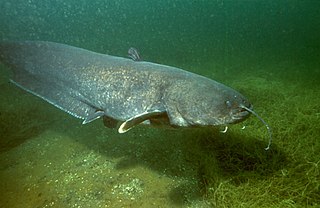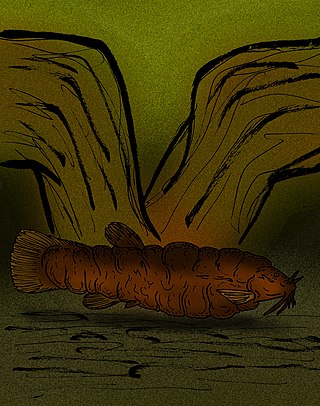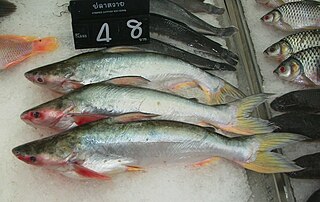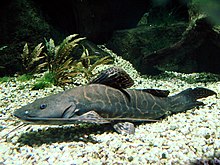
Catfish are a diverse group of ray-finned fish. Named for their prominent barbels, which resemble a cat's whiskers, catfish range in size and behavior from the three largest species alive, the Mekong giant catfish from Southeast Asia, the wels catfish of Eurasia, and the piraíba of South America, to detritivores, and even to a tiny parasitic species commonly called the candiru, Vandellia cirrhosa. Neither the armour-plated types nor the naked types have scales. Despite their name, not all catfish have prominent barbels or "whiskers". Members of the Siluriformes order are defined by features of the skull and swimbladder. Catfish are of considerable commercial importance; many of the larger species are farmed or fished for food. Many of the smaller species, particularly the genus Corydoras, are important in the aquarium hobby. Many catfish are nocturnal, but others are crepuscular or diurnal.

Lake Tanganyika is an African Great Lake. It is the second-oldest freshwater lake in the world, the second-largest by volume, and the second-deepest, in all cases after Lake Baikal in Siberia. It is the world's longest freshwater lake. The lake is shared among four countries—Tanzania, the Democratic Republic of the Congo (DRC), Burundi, and Zambia, with Tanzania (46%) and DRC (40%) possessing the majority of the lake. It drains into the Congo River system and ultimately into the Atlantic Ocean.

The iridescent shark,iridescent shark catfish is a species of shark catfish native to the rivers of Southeast Asia. Despite its name, it is not a shark. It is found in the Mekong basin as well as the Chao Phraya River, and is heavily cultivated for food there.

The brown bullhead is a fish of the family Ictaluridae that is widely distributed in North America. It is a species of bullhead catfish and is similar to the black bullhead and yellow bullhead. It was originally described as Pimelodus nebulosus by Charles Alexandre Lesueur in 1819, and is also referred to as Ictalurus nebulosus.

The blue catfish is a large species of North American catfish, reaching a length of 65 in (170 cm) and a weight of 165 lb (75 kg). The continent’s largest, it can live to 20 years, with a typical fish being between 25–46 in (64–117 cm) and 30–70 lb (14–32 kg). Native distribution is primarily in the Mississippi River and Louisiana drainage systems, including the Missouri, Ohio, Tennessee, and Arkansas Rivers, the Des Moines River in south-central Iowa, the Rio Grande, and south along the Gulf Coast to Belize and Guatemala.

The eel-tailed catfish, Tandanus tandanus, is a species of catfish of the family Plotosidae. This fish is also known as dewfish, freshwater catfish, jewfish, and tandan.

Basa is a species of catfish in the family Pangasiidae. Basa are native to the Mekong and Chao Phraya basins in Mainland Southeast Asia. These fish are important as a food source, and also on the international market. They are often labelled in North America and Australia as "basa fish", "swai", or "bocourti". In the UK all species of Pangasius may legally be described as "river cobbler", "cobbler", "basa", "pangasius", "panga", or any of these with the addition of "catfish". In the rest of Europe, these fish are commonly marketed as "pangasius" or "panga". In Asian markets, names for basa include "Pacific dory" and "patin". Other related shark catfish may occasionally be incorrectly labeled as basa fish, including P. hypophthalmus and P. pangasius.

The wels catfish, also called sheatfish or just wels, is a large species of catfish native to wide areas of central, southern, and eastern Europe, in the basins of the Baltic, Black and Caspian Seas. It has been introduced to Western Europe as a prized sport fish and is now found from the United Kingdom east to Kazakhstan and China and south to Greece and Turkey. The wels is the largest freshwater fish in Europe. The longest wels on record was an unweighed specimen from the Po river in Italy, measuring 2.85 m (9.4 ft), captured in 2023.

The redtail catfish, Phractocephalus hemioliopterus, is a pimelodid (long-whiskered) catfish. In Venezuela, it is known as cajaro, in Guyana, it is known as a banana catfish, and in Brazil, it is known as pirarara, stemming from the Tupi language words pirá and arara. It is the only extant species of the genus Phractocephalus. This fish is common in the aquarium trade, although its massive adult size makes it unsuitable for all but the largest aquariums. They feed on fish, crustaceans and fallen fruits. They are not evaluated by IUCN.
Leopard catfish may refer to:

Rhizosomichthys totae is a species of catfish of the family Trichomycteridae, and the only species of the genus Rhizosomichthys. This fish grew to about 13.8 centimetres (5.4 in) and was endemic to Colombia where it occurred in the Lake Tota basin. It is listed as a critically endangered species by the IUCN Red List. The species was last seen in 1957, and only 10 specimens were ever found. The disappearance is possibly linked to the release of 100,000 imported rainbow trout eggs into Lake Tota in 1936.
The New Granada sea catfish, or Cazon sea catfish is a species of catfish in the family Ariidae. It is endemic to the Atrato and Magdalena River basins in Colombia.

Ictalurus lupus is a species of catfish in the family Ictaluridae. It resembles the closely related channel catfish, but is smaller, lacks spots, and has a caudal fin with a shallower fork, and grows to a total length of 48 cm (19 in). It is found in Northeastern Mexico and the Southwestern United States.

Pangasius pangasius, the Pangas catfish, is a species of shark catfish native to fresh and brackish waters of Bangladesh, India, Myanmar, and Pakistan. It has also been introduced to Cambodia and Vietnam. This species grows to a standard length of 3 metres (9.8 ft). This species South Asia, the other being P. silasi from the Krishna River.

Cavefish or cave fish is a generic term for fresh and brackish water fish adapted to life in caves and other underground habitats. Related terms are subterranean fish, troglomorphic fish, troglobitic fish, stygobitic fish, phreatic fish, and hypogean fish.

The white bullhead, also known as the white catfish, is a member of the family Ictaluridae of the order Siluriformes.

Silurus asotus, commonly called the Japanese common catfish, Amur catfish, Far Eastern catfish, and Chinese catfish, is a catfish species belonging to the Siluridae family. It lives in widespread distribution in freshwater habitats across East Asia and Japan. As a freshwater species, it can be found only in the catchments of rivers, ponds, and lakes located in China, Japan, the Korean Peninsula, Taiwan, and the Russian Amur Basin. This species of catfish is carnivorous and has a high aquaculture.

This list is of the heaviest European freshwater fish caught using the traditional angling method of rod and line.

The Pemecou sea catfish, also known as the flapnose sea catfish, the mud cuirass, or the gillbacker, is a species of catfish in the family Ariidae. It was described by Marcus Elieser Bloch in 1794, originally under the genus Silurus. It inhabits marine, brackish and freshwaters in Brazil, Guyana, French Guiana, Colombia, Suriname, Venezuela, and Trinidad and Tobago. It dwells at a depth range of 1 to 5 m. It reaches a maximum total length of 94.2 cm (37.1 in), while males more commonly reach a TL of 30 cm (12 in) and females reach a TL of 62.5 cm (24.6 in). It reaches a maximum weight of 1.5 kg (3.3 lb).

Leiarius pictus, commonly as sailfin pim, painted catfish or saddle catfish, is a species of demersal catfish of the family Pimelodidae that is native to Amazon, Essequibo, and Orinoco River basins of Colombia, Venezuela, Peru and Brazil.



















